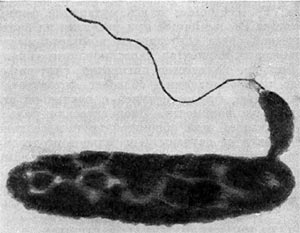 With the rise of antibiotic resistance in important bacterial pathogens, attention is being focused on alternative treatments for bacterial infections. The most prominent among these is phage therapy. Another potential antimicrobial agent is the predatory bacteria Bdellovibrio and related species
With the rise of antibiotic resistance in important bacterial pathogens, attention is being focused on alternative treatments for bacterial infections. The most prominent among these is phage therapy. Another potential antimicrobial agent is the predatory bacteria Bdellovibrio and related speciesI am not sure how likely it is that these bacteria will ever find use as therapeutic agents, but they are pretty amazing organisms and they definitely have the potential to be used in this way.
Bdellovibrio have a truly predatory life style. They require specific species of gram negative bacteria to grow. The cells are small and highly motile. When they encounter a susceptible host cell, they attach themselves to the outer surface of the cell, bore a hole in the cell wall and push themselves into the periplasmic space (the space between the outer membrane and cytoplasmic membrane of gram negative bacteria). Once there the cell is killed and its contents consumed. Bdellovibrio reproduces within the cell and once the contents of the prey are consumed, the daughter cells will burst out of the shell of the dead prey cell and head off to find other targets.

5 comments:
Cool! Is there any known similar 'bug', which would thrive on archaea?
Marek,
Bdellovibrio attack only gram negative bacteria because they need that periplasmic space. If there is a parasite of archaea, it would need a different mode of growth. The Micavibrio are a related genus that is an exoparasite but I think it also only preys on gram negatives. So I don't know.
Marek,
Another thing you'll like about them is that since they have an obligate relationship with the bacterial host and they lyse the cells they attack, you work with them like you do phage. They make plaques in overlay plates.
Bacterias are like predators but I think there are others which attack the bad cells we've in our bodies.
Here are some more bacterial predators:
Myxobacteria (several species actually), Vampirococcus.
A thing with Bdellovibrio being used as a potential predator for human pathogens, is that, since it attacks Gram -negative bacteria, several species with which we are mutualists would also be attacked... Which is not good...
Post a Comment